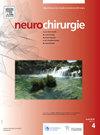Impact of dural closure on postoperative complications in cerebellar metastasis surgery: A retrospective cohort study
IF 1.4
4区 医学
Q4 CLINICAL NEUROLOGY
引用次数: 0
Abstract
Introduction
Cerebellar metastases represent the second most common location for brain metastases. Surgery is a key therapeutic option, but the rate of postoperative complications remains high. The impact of dural closure techniques on these complications has not yet been specifically evaluated.
Methods
We conducted a retrospective single-center study including all patients who underwent surgical resection of cerebellar metastasis between 2012 and 2021 at Caen University Hospital. The primary outcome was the occurrence of a postoperative complication withing 30 days (death, reoperation, or meningitis). We analyzed surgical data, particularly focusing on the type of dural closure: watertight (with sutured closure ± suturable duraplasty) versus non-watertight (non-sealing suture ± non-suturable patch).
Results
A total of 125 surgeries were analyzed. Postoperative complications occurred in 25% of cases, including hydrocephalus (10%), meningitis (9%), and cerebrospinal fluid leaks (8%). Watertight dural closure was significantly associated with a higher rate of complications (p = 0.039). Median overall survival was 10 months and complications were associated with shorter survival (p = 0.011).
Conclusion
Watertight dural closure appears to increase the risk of postoperative complications in cerebellar metastasis surgery. These findings question the relevance of systematic watertight dural suturing in the posterior fossa.
硬脑膜闭合对小脑转移手术术后并发症的影响:一项回顾性队列研究
小脑转移是第二常见的脑转移部位。手术是一个关键的治疗选择,但术后并发症的发生率仍然很高。硬脑膜闭合技术对这些并发症的影响尚未得到具体评估。方法:我们进行了一项回顾性单中心研究,纳入了2012年至2021年在卡昂大学医院接受小脑转移手术切除的所有患者。主要终点是30天内发生的术后并发症(死亡、再手术或脑膜炎)。我们分析了手术数据,特别关注硬脑膜闭合的类型:水密(缝合闭合±可缝合的硬脑膜成形术)与非水密(非密封缝合±不可缝合的贴片)。结果共分析125例手术。25%的病例出现术后并发症,包括脑积水(10%)、脑膜炎(9%)和脑脊液漏(8%)。水密硬脑膜闭合与并发症发生率显著相关(p = 0.039)。中位总生存期为10个月,并发症与较短生存期相关(p = 0.011)。结论水密硬脑膜闭合增加了小脑转移手术术后并发症的发生风险。这些发现对后窝系统水密硬脑膜缝合的相关性提出了质疑。
本文章由计算机程序翻译,如有差异,请以英文原文为准。
求助全文
约1分钟内获得全文
求助全文
来源期刊

Neurochirurgie
医学-临床神经学
CiteScore
2.70
自引率
6.20%
发文量
100
审稿时长
29 days
期刊介绍:
Neurochirurgie publishes articles on treatment, teaching and research, neurosurgery training and the professional aspects of our discipline, and also the history and progress of neurosurgery. It focuses on pathologies of the head, spine and central and peripheral nervous systems and their vascularization. All aspects of the specialty are dealt with: trauma, tumor, degenerative disease, infection, vascular pathology, and radiosurgery, and pediatrics. Transversal studies are also welcome: neuroanatomy, neurophysiology, neurology, neuropediatrics, psychiatry, neuropsychology, physical medicine and neurologic rehabilitation, neuro-anesthesia, neurologic intensive care, neuroradiology, functional exploration, neuropathology, neuro-ophthalmology, otoneurology, maxillofacial surgery, neuro-endocrinology and spine surgery. Technical and methodological aspects are also taken onboard: diagnostic and therapeutic techniques, methods for assessing results, epidemiology, surgical, interventional and radiological techniques, simulations and pathophysiological hypotheses, and educational tools. The editorial board may refuse submissions that fail to meet the journal''s aims and scope; such studies will not be peer-reviewed, and the editor in chief will promptly inform the corresponding author, so as not to delay submission to a more suitable journal.
With a view to attracting an international audience of both readers and writers, Neurochirurgie especially welcomes articles in English, and gives priority to original studies. Other kinds of article - reviews, case reports, technical notes and meta-analyses - are equally published.
Every year, a special edition is dedicated to the topic selected by the French Society of Neurosurgery for its annual report.
 求助内容:
求助内容: 应助结果提醒方式:
应助结果提醒方式:


